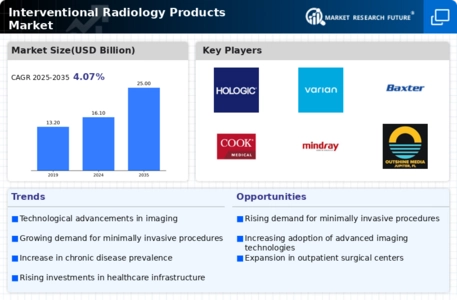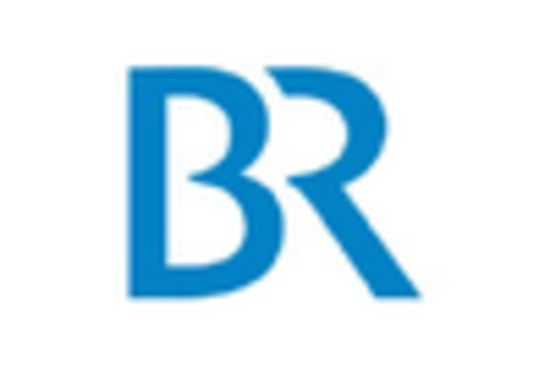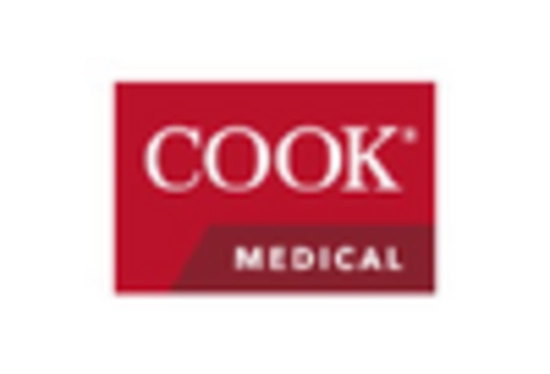Catheters
Guide Wires
Embolic Agents
Radiology Visualization Systems
Ablation Devices
Angiography
Biliary Interventions
Biopsy
Drainage Procedures
Ablation
Hospitals
Ambulatory Surgical Centers
Diagnostic Imaging Centers
Oncology
Cardiology
Urology
Neurology
North America
Europe
South America
Asia Pacific
Middle East and Africa
North America Outlook (USD Billion, 2019-2035)
North America Interventional Radiology Products Market by Product Type
Catheters
Guide Wires
Embolic Agents
Radiology Visualization Systems
Ablation Devices
North America Interventional Radiology Products Market by Procedure Type
Angiography
Biliary Interventions
Biopsy
Drainage Procedures
Ablation
North America Interventional Radiology Products Market by End User Type
Hospitals
Ambulatory Surgical Centers
Diagnostic Imaging Centers
North America Interventional Radiology Products Market by Application Type
Oncology
Cardiology
Urology
Neurology
North America Interventional Radiology Products Market by Regional Type
US
Canada
US Outlook (USD Billion, 2019-2035)
US Interventional Radiology Products Market by Product Type
Catheters
Guide Wires
Embolic Agents
Radiology Visualization Systems
Ablation Devices
US Interventional Radiology Products Market by Procedure Type
Angiography
Biliary Interventions
Biopsy
Drainage Procedures
Ablation
US Interventional Radiology Products Market by End User Type
Hospitals
Ambulatory Surgical Centers
Diagnostic Imaging Centers
US Interventional Radiology Products Market by Application Type
Oncology
Cardiology
Urology
Neurology
CANADA Outlook (USD Billion, 2019-2035)
CANADA Interventional Radiology Products Market by Product Type
Catheters
Guide Wires
Embolic Agents
Radiology Visualization Systems
Ablation Devices
CANADA Interventional Radiology Products Market by Procedure Type
Angiography
Biliary Interventions
Biopsy
Drainage Procedures
Ablation
CANADA Interventional Radiology Products Market by End User Type
Hospitals
Ambulatory Surgical Centers
Diagnostic Imaging Centers
CANADA Interventional Radiology Products Market by Application Type
Oncology
Cardiology
Urology
Neurology
Europe Outlook (USD Billion, 2019-2035)
Europe Interventional Radiology Products Market by Product Type
Catheters
Guide Wires
Embolic Agents
Radiology Visualization Systems
Ablation Devices
Europe Interventional Radiology Products Market by Procedure Type
Angiography
Biliary Interventions
Biopsy
Drainage Procedures
Ablation
Europe Interventional Radiology Products Market by End User Type
Hospitals
Ambulatory Surgical Centers
Diagnostic Imaging Centers
Europe Interventional Radiology Products Market by Application Type
Oncology
Cardiology
Urology
Neurology
Europe Interventional Radiology Products Market by Regional Type
Germany
UK
France
Russia
Italy
Spain
Rest of Europe
GERMANY Outlook (USD Billion, 2019-2035)
GERMANY Interventional Radiology Products Market by Product Type
Catheters
Guide Wires
Embolic Agents
Radiology Visualization Systems
Ablation Devices
GERMANY Interventional Radiology Products Market by Procedure Type
Angiography
Biliary Interventions
Biopsy
Drainage Procedures
Ablation
GERMANY Interventional Radiology Products Market by End User Type
Hospitals
Ambulatory Surgical Centers
Diagnostic Imaging Centers
GERMANY Interventional Radiology Products Market by Application Type
Oncology
Cardiology
Urology
Neurology
UK Outlook (USD Billion, 2019-2035)
UK Interventional Radiology Products Market by Product Type
Catheters
Guide Wires
Embolic Agents
Radiology Visualization Systems
Ablation Devices
UK Interventional Radiology Products Market by Procedure Type
Angiography
Biliary Interventions
Biopsy
Drainage Procedures
Ablation
UK Interventional Radiology Products Market by End User Type
Hospitals
Ambulatory Surgical Centers
Diagnostic Imaging Centers
UK Interventional Radiology Products Market by Application Type
Oncology
Cardiology
Urology
Neurology
FRANCE Outlook (USD Billion, 2019-2035)
FRANCE Interventional Radiology Products Market by Product Type
Catheters
Guide Wires
Embolic Agents
Radiology Visualization Systems
Ablation Devices
FRANCE Interventional Radiology Products Market by Procedure Type
Angiography
Biliary Interventions
Biopsy
Drainage Procedures
Ablation
FRANCE Interventional Radiology Products Market by End User Type
Hospitals
Ambulatory Surgical Centers
Diagnostic Imaging Centers
FRANCE Interventional Radiology Products Market by Application Type
Oncology
Cardiology
Urology
Neurology
RUSSIA Outlook (USD Billion, 2019-2035)
RUSSIA Interventional Radiology Products Market by Product Type
Catheters
Guide Wires
Embolic Agents
Radiology Visualization Systems
Ablation Devices
RUSSIA Interventional Radiology Products Market by Procedure Type
Angiography
Biliary Interventions
Biopsy
Drainage Procedures
Ablation
RUSSIA Interventional Radiology Products Market by End User Type
Hospitals
Ambulatory Surgical Centers
Diagnostic Imaging Centers
RUSSIA Interventional Radiology Products Market by Application Type
Oncology
Cardiology
Urology
Neurology
ITALY Outlook (USD Billion, 2019-2035)
ITALY Interventional Radiology Products Market by Product Type
Catheters
Guide Wires
Embolic Agents
Radiology Visualization Systems
Ablation Devices
ITALY Interventional Radiology Products Market by Procedure Type
Angiography
Biliary Interventions
Biopsy
Drainage Procedures
Ablation
ITALY Interventional Radiology Products Market by End User Type
Hospitals
Ambulatory Surgical Centers
Diagnostic Imaging Centers
ITALY Interventional Radiology Products Market by Application Type
Oncology
Cardiology
Urology
Neurology
SPAIN Outlook (USD Billion, 2019-2035)
SPAIN Interventional Radiology Products Market by Product Type
Catheters
Guide Wires
Embolic Agents
Radiology Visualization Systems
Ablation Devices
SPAIN Interventional Radiology Products Market by Procedure Type
Angiography
Biliary Interventions
Biopsy
Drainage Procedures
Ablation
SPAIN Interventional Radiology Products Market by End User Type
Hospitals
Ambulatory Surgical Centers
Diagnostic Imaging Centers
SPAIN Interventional Radiology Products Market by Application Type
Oncology
Cardiology
Urology
Neurology
REST OF EUROPE Outlook (USD Billion, 2019-2035)
REST OF EUROPE Interventional Radiology Products Market by Product Type
Catheters
Guide Wires
Embolic Agents
Radiology Visualization Systems
Ablation Devices
REST OF EUROPE Interventional Radiology Products Market by Procedure Type
Angiography
Biliary Interventions
Biopsy
Drainage Procedures
Ablation
REST OF EUROPE Interventional Radiology Products Market by End User Type
Hospitals
Ambulatory Surgical Centers
Diagnostic Imaging Centers
REST OF EUROPE Interventional Radiology Products Market by Application Type
Oncology
Cardiology
Urology
Neurology
APAC Outlook (USD Billion, 2019-2035)
APAC Interventional Radiology Products Market by Product Type
Catheters
Guide Wires
Embolic Agents
Radiology Visualization Systems
Ablation Devices
APAC Interventional Radiology Products Market by Procedure Type
Angiography
Biliary Interventions
Biopsy
Drainage Procedures
Ablation
APAC Interventional Radiology Products Market by End User Type
Hospitals
Ambulatory Surgical Centers
Diagnostic Imaging Centers
APAC Interventional Radiology Products Market by Application Type
Oncology
Cardiology
Urology
Neurology
APAC Interventional Radiology Products Market by Regional Type
China
India
Japan
South Korea
Malaysia
Thailand
Indonesia
Rest of APAC
CHINA Outlook (USD Billion, 2019-2035)
CHINA Interventional Radiology Products Market by Product Type
Catheters
Guide Wires
Embolic Agents
Radiology Visualization Systems
Ablation Devices
CHINA Interventional Radiology Products Market by Procedure Type
Angiography
Biliary Interventions
Biopsy
Drainage Procedures
Ablation
CHINA Interventional Radiology Products Market by End User Type
Hospitals
Ambulatory Surgical Centers
Diagnostic Imaging Centers
CHINA Interventional Radiology Products Market by Application Type
Oncology
Cardiology
Urology
Neurology
INDIA Outlook (USD Billion, 2019-2035)
INDIA Interventional Radiology Products Market by Product Type
Catheters
Guide Wires
Embolic Agents
Radiology Visualization Systems
Ablation Devices
INDIA Interventional Radiology Products Market by Procedure Type
Angiography
Biliary Interventions
Biopsy
Drainage Procedures
Ablation
INDIA Interventional Radiology Products Market by End User Type
Hospitals
Ambulatory Surgical Centers
Diagnostic Imaging Centers
INDIA Interventional Radiology Products Market by Application Type
Oncology
Cardiology
Urology
Neurology
JAPAN Outlook (USD Billion, 2019-2035)
JAPAN Interventional Radiology Products Market by Product Type
Catheters
Guide Wires
Embolic Agents
Radiology Visualization Systems
Ablation Devices
JAPAN Interventional Radiology Products Market by Procedure Type
Angiography
Biliary Interventions
Biopsy
Drainage Procedures
Ablation
JAPAN Interventional Radiology Products Market by End User Type
Hospitals
Ambulatory Surgical Centers
Diagnostic Imaging Centers
JAPAN Interventional Radiology Products Market by Application Type
Oncology
Cardiology
Urology
Neurology
SOUTH KOREA Outlook (USD Billion, 2019-2035)
SOUTH KOREA Interventional Radiology Products Market by Product Type
Catheters
Guide Wires
Embolic Agents
Radiology Visualization Systems
Ablation Devices
SOUTH KOREA Interventional Radiology Products Market by Procedure Type
Angiography
Biliary Interventions
Biopsy
Drainage Procedures
Ablation
SOUTH KOREA Interventional Radiology Products Market by End User Type
Hospitals
Ambulatory Surgical Centers
Diagnostic Imaging Centers
SOUTH KOREA Interventional Radiology Products Market by Application Type
Oncology
Cardiology
Urology
Neurology
MALAYSIA Outlook (USD Billion, 2019-2035)
MALAYSIA Interventional Radiology Products Market by Product Type
Catheters
Guide Wires
Embolic Agents
Radiology Visualization Systems
Ablation Devices
MALAYSIA Interventional Radiology Products Market by Procedure Type
Angiography
Biliary Interventions
Biopsy
Drainage Procedures
Ablation
MALAYSIA Interventional Radiology Products Market by End User Type
Hospitals
Ambulatory Surgical Centers
Diagnostic Imaging Centers
MALAYSIA Interventional Radiology Products Market by Application Type
Oncology
Cardiology
Urology
Neurology
THAILAND Outlook (USD Billion, 2019-2035)
THAILAND Interventional Radiology Products Market by Product Type
Catheters
Guide Wires
Embolic Agents
Radiology Visualization Systems
Ablation Devices
THAILAND Interventional Radiology Products Market by Procedure Type
Angiography
Biliary Interventions
Biopsy
Drainage Procedures
Ablation
THAILAND Interventional Radiology Products Market by End User Type
Hospitals
Ambulatory Surgical Centers
Diagnostic Imaging Centers
THAILAND Interventional Radiology Products Market by Application Type
Oncology
Cardiology
Urology
Neurology
INDONESIA Outlook (USD Billion, 2019-2035)
INDONESIA Interventional Radiology Products Market by Product Type
Catheters
Guide Wires
Embolic Agents
Radiology Visualization Systems
Ablation Devices
INDONESIA Interventional Radiology Products Market by Procedure Type
Angiography
Biliary Interventions
Biopsy
Drainage Procedures
Ablation
INDONESIA Interventional Radiology Products Market by End User Type
Hospitals
Ambulatory Surgical Centers
Diagnostic Imaging Centers
INDONESIA Interventional Radiology Products Market by Application Type
Oncology
Cardiology
Urology
Neurology
REST OF APAC Outlook (USD Billion, 2019-2035)
REST OF APAC Interventional Radiology Products Market by Product Type
Catheters
Guide Wires
Embolic Agents
Radiology Visualization Systems
Ablation Devices
REST OF APAC Interventional Radiology Products Market by Procedure Type
Angiography
Biliary Interventions
Biopsy
Drainage Procedures
Ablation
REST OF APAC Interventional Radiology Products Market by End User Type
Hospitals
Ambulatory Surgical Centers
Diagnostic Imaging Centers
REST OF APAC Interventional Radiology Products Market by Application Type
Oncology
Cardiology
Urology
Neurology
South America Outlook (USD Billion, 2019-2035)
South America Interventional Radiology Products Market by Product Type
Catheters
Guide Wires
Embolic Agents
Radiology Visualization Systems
Ablation Devices
South America Interventional Radiology Products Market by Procedure Type
Angiography
Biliary Interventions
Biopsy
Drainage Procedures
Ablation
South America Interventional Radiology Products Market by End User Type
Hospitals
Ambulatory Surgical Centers
Diagnostic Imaging Centers
South America Interventional Radiology Products Market by Application Type
Oncology
Cardiology
Urology
Neurology
South America Interventional Radiology Products Market by Regional Type
Brazil
Mexico
Argentina
Rest of South America
BRAZIL Outlook (USD Billion, 2019-2035)
BRAZIL Interventional Radiology Products Market by Product Type
Catheters
Guide Wires
Embolic Agents
Radiology Visualization Systems
Ablation Devices
BRAZIL Interventional Radiology Products Market by Procedure Type
Angiography
Biliary Interventions
Biopsy
Drainage Procedures
Ablation
BRAZIL Interventional Radiology Products Market by End User Type
Hospitals
Ambulatory Surgical Centers
Diagnostic Imaging Centers
BRAZIL Interventional Radiology Products Market by Application Type
Oncology
Cardiology
Urology
Neurology
MEXICO Outlook (USD Billion, 2019-2035)
MEXICO Interventional Radiology Products Market by Product Type
Catheters
Guide Wires
Embolic Agents
Radiology Visualization Systems
Ablation Devices
MEXICO Interventional Radiology Products Market by Procedure Type
Angiography
Biliary Interventions
Biopsy
Drainage Procedures
Ablation
MEXICO Interventional Radiology Products Market by End User Type
Hospitals
Ambulatory Surgical Centers
Diagnostic Imaging Centers
MEXICO Interventional Radiology Products Market by Application Type
Oncology
Cardiology
Urology
Neurology
ARGENTINA Outlook (USD Billion, 2019-2035)
ARGENTINA Interventional Radiology Products Market by Product Type
Catheters
Guide Wires
Embolic Agents
Radiology Visualization Systems
Ablation Devices
ARGENTINA Interventional Radiology Products Market by Procedure Type
Angiography
Biliary Interventions
Biopsy
Drainage Procedures
Ablation
ARGENTINA Interventional Radiology Products Market by End User Type
Hospitals
Ambulatory Surgical Centers
Diagnostic Imaging Centers
ARGENTINA Interventional Radiology Products Market by Application Type
Oncology
Cardiology
Urology
Neurology
REST OF SOUTH AMERICA Outlook (USD Billion, 2019-2035)
REST OF SOUTH AMERICA Interventional Radiology Products Market by Product Type
Catheters
Guide Wires
Embolic Agents
Radiology Visualization Systems
Ablation Devices
REST OF SOUTH AMERICA Interventional Radiology Products Market by Procedure Type
Angiography
Biliary Interventions
Biopsy
Drainage Procedures
Ablation
REST OF SOUTH AMERICA Interventional Radiology Products Market by End User Type
Hospitals
Ambulatory Surgical Centers
Diagnostic Imaging Centers
REST OF SOUTH AMERICA Interventional Radiology Products Market by Application Type
Oncology
Cardiology
Urology
Neurology
MEA Outlook (USD Billion, 2019-2035)
MEA Interventional Radiology Products Market by Product Type
Catheters
Guide Wires
Embolic Agents
Radiology Visualization Systems
Ablation Devices
MEA Interventional Radiology Products Market by Procedure Type
Angiography
Biliary Interventions
Biopsy
Drainage Procedures
Ablation
MEA Interventional Radiology Products Market by End User Type
Hospitals
Ambulatory Surgical Centers
Diagnostic Imaging Centers
MEA Interventional Radiology Products Market by Application Type
Oncology
Cardiology
Urology
Neurology
MEA Interventional Radiology Products Market by Regional Type
GCC Countries
South Africa
Rest of MEA
GCC COUNTRIES Outlook (USD Billion, 2019-2035)
GCC COUNTRIES Interventional Radiology Products Market by Product Type
Catheters
Guide Wires
Embolic Agents
Radiology Visualization Systems
Ablation Devices
GCC COUNTRIES Interventional Radiology Products Market by Procedure Type
Angiography
Biliary Interventions
Biopsy
Drainage Procedures
Ablation
GCC COUNTRIES Interventional Radiology Products Market by End User Type
Hospitals
Ambulatory Surgical Centers
Diagnostic Imaging Centers
GCC COUNTRIES Interventional Radiology Products Market by Application Type
Oncology
Cardiology
Urology
Neurology
SOUTH AFRICA Outlook (USD Billion, 2019-2035)
SOUTH AFRICA Interventional Radiology Products Market by Product Type
Catheters
Guide Wires
Embolic Agents
Radiology Visualization Systems
Ablation Devices
SOUTH AFRICA Interventional Radiology Products Market by Procedure Type
Angiography
Biliary Interventions
Biopsy
Drainage Procedures
Ablation
SOUTH AFRICA Interventional Radiology Products Market by End User Type
Hospitals
Ambulatory Surgical Centers
Diagnostic Imaging Centers
SOUTH AFRICA Interventional Radiology Products Market by Application Type
Oncology
Cardiology
Urology
Neurology
REST OF MEA Outlook (USD Billion, 2019-2035)
REST OF MEA Interventional Radiology Products Market by Product Type
Catheters
Guide Wires
Embolic Agents
Radiology Visualization Systems
Ablation Devices
REST OF MEA Interventional Radiology Products Market by Procedure Type
Angiography
Biliary Interventions
Biopsy
Drainage Procedures
Ablation
REST OF MEA Interventional Radiology Products Market by End User Type
Hospitals
Ambulatory Surgical Centers
Diagnostic Imaging Centers
REST OF MEA Interventional Radiology Products Market by Application Type
Oncology
Cardiology
Urology
Neurology

















Leave a Comment